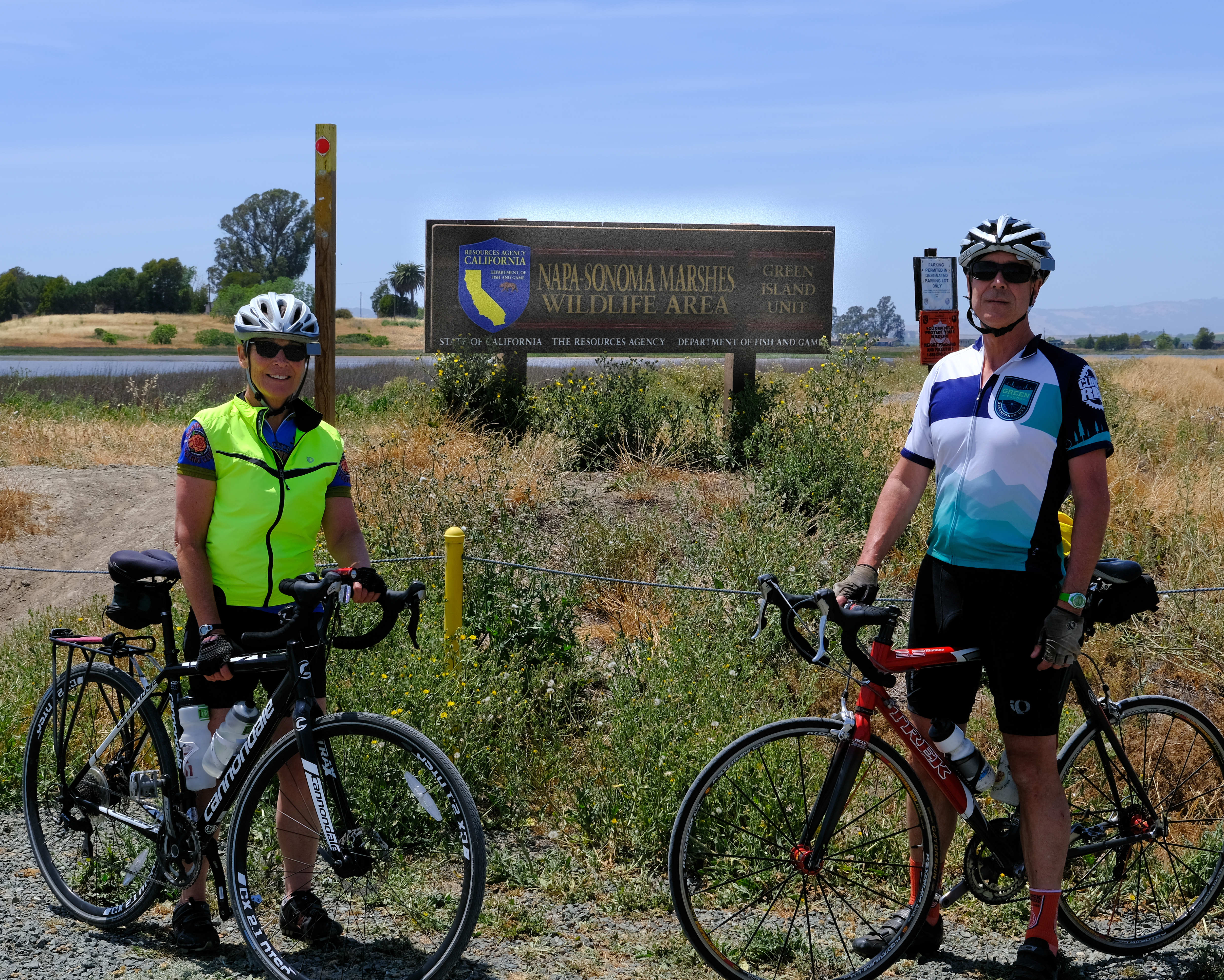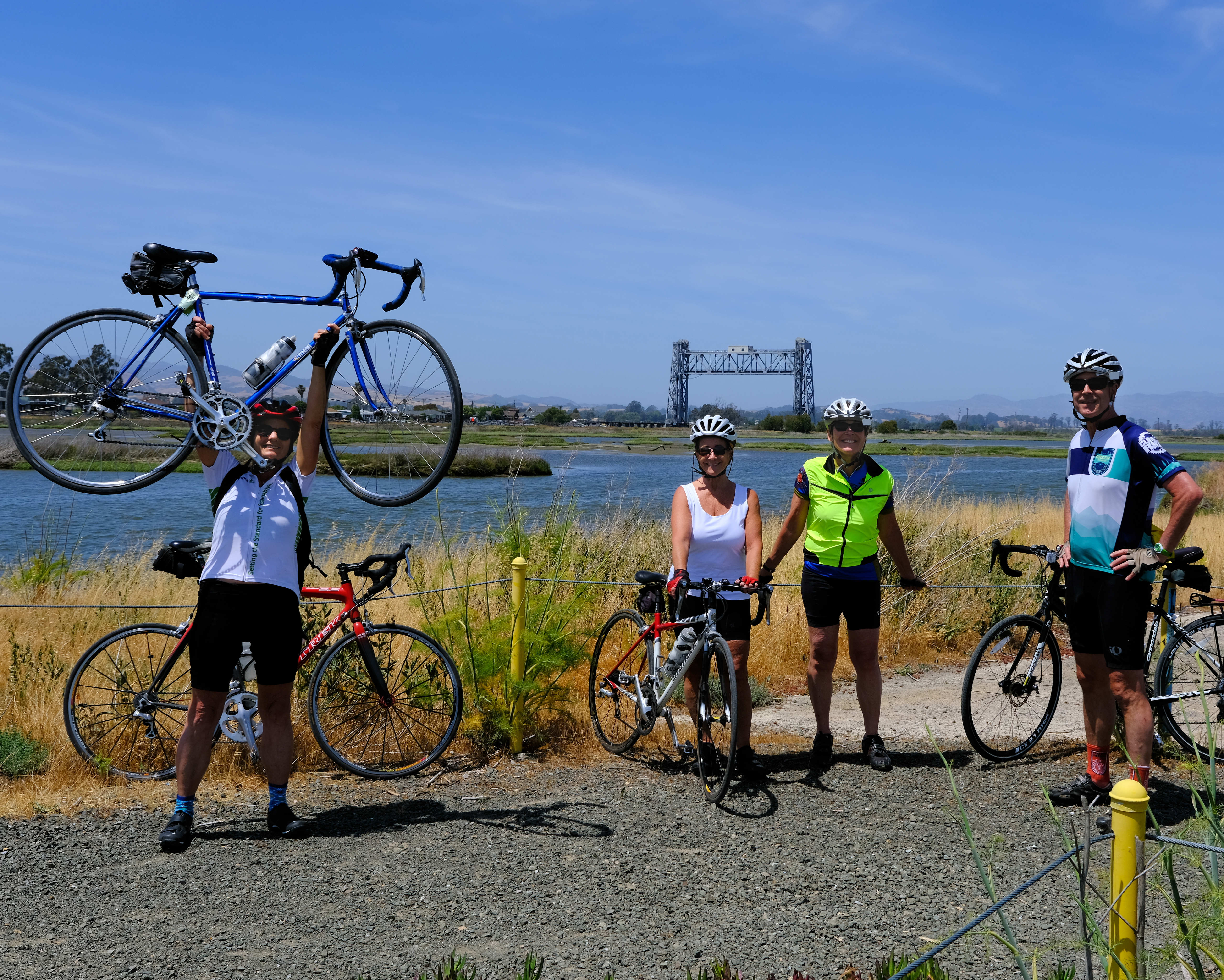 There actually is a Green Island at the end of Green Island Road, as we discovered during the Napa Climate NOW! Road to 350 Climate Ride on June 5. It’s an isolated island, formerly farmland surrounded by salt ponds, that is connected by a levee road to Green Island Road. It’s also part of the Green Island Unit of the Napa-Sonoma Marshes Wildlife Area, managed by the Department of Fish and Wildlife. And it made a fascinating stop along the Napa River Bay Trail at Wetlands Edge Park in American Canyon. (Photo credits: Nick Cheranich)
There actually is a Green Island at the end of Green Island Road, as we discovered during the Napa Climate NOW! Road to 350 Climate Ride on June 5. It’s an isolated island, formerly farmland surrounded by salt ponds, that is connected by a levee road to Green Island Road. It’s also part of the Green Island Unit of the Napa-Sonoma Marshes Wildlife Area, managed by the Department of Fish and Wildlife. And it made a fascinating stop along the Napa River Bay Trail at Wetlands Edge Park in American Canyon. (Photo credits: Nick Cheranich)
The waters, wetlands, and uplands along the trail are part of an interconnected watershed system that drains into the San Francisco Bay. Before the 1850’s, San Francisco Bay had edges with extensive, miles-wide tidal marshes.
 Native Americans from three different tribes (Patwin, Coast Miwok, and Wappo) lived in the Napa Valley and along the lower Napa River for thousands of years. They relied on the abundant natural resources of the area, hunting for elk, deer and bear, as well as waterfowl and small mammals. They also fished in the creeks and marsh sloughs and gathered shellfish such as mussels.
Native Americans from three different tribes (Patwin, Coast Miwok, and Wappo) lived in the Napa Valley and along the lower Napa River for thousands of years. They relied on the abundant natural resources of the area, hunting for elk, deer and bear, as well as waterfowl and small mammals. They also fished in the creeks and marsh sloughs and gathered shellfish such as mussels.
Their way of life was changed forever with the arrival of Spanish and Mexican explorers in the late 1700s and the establishment of the nearby Mission in Sonoma. Native Americans fared poorly during these times. Many were forced to work on the ranchos and suffered during a smallpox epidemic in the 1830s. Following the transfer of California to the United States in 1848, others were forced off of their ancestral lands and sent to reservations.
By the 1950’s, nearly 85% of these marshlands had been diked or filled. The low-lying flood plains found in American Canyon include mudflats, tidal and seasonal wetlands, former salt ponds, riparian corridors, and lands reclaimed for agriculture and development.
In 2006, the City restored the low-lying floodplains to tidal and seasonal wetlands. The Napa River Bay Trail, completed by the Napa County Regional Park and Open Space District, opened in June of 2010. (This history is from The City of American Canyon website.)
 A bike ride or walk along the trail is a great way to view these wetlands and the animals and birds they shelter up close (you can also drive to Green Island by following Green Island Road to the Wildlife Area sign and turning left). Wetlands also provide ecosystem services to our human coastal communities—services that will become even more important as we adapt to a warming climate and sea level rise. These areas function as natural sponges that trap and slowly release surface water, rain, groundwater, and flood waters and distribute these waters more slowly over the floodplain, thereby lowering flood heights and dissipating storm surge. Large amounts of wave energy and water from storms that may otherwise do extensive inland damage are absorbed by coastal wetlands. Some research indicates that the height of storm surge can be reduced by one foot for every mile of vegetative wetlands that exists. Wetlands reduce pollution of waterways by storing and filtering urban runoff and removing or retaining nutrients and sediment carried by runoff. Wetlands play a unique and critical function through their ability to recycle these nutrients into usable substances.
A bike ride or walk along the trail is a great way to view these wetlands and the animals and birds they shelter up close (you can also drive to Green Island by following Green Island Road to the Wildlife Area sign and turning left). Wetlands also provide ecosystem services to our human coastal communities—services that will become even more important as we adapt to a warming climate and sea level rise. These areas function as natural sponges that trap and slowly release surface water, rain, groundwater, and flood waters and distribute these waters more slowly over the floodplain, thereby lowering flood heights and dissipating storm surge. Large amounts of wave energy and water from storms that may otherwise do extensive inland damage are absorbed by coastal wetlands. Some research indicates that the height of storm surge can be reduced by one foot for every mile of vegetative wetlands that exists. Wetlands reduce pollution of waterways by storing and filtering urban runoff and removing or retaining nutrients and sediment carried by runoff. Wetlands play a unique and critical function through their ability to recycle these nutrients into usable substances.
Last May the Sierra Club sponsored a webinar on “Sea Level Rise: Why We Need Nature-Based Adaptation”. The presentations pointed out the importance of the wetlands and marshes in the North Bay and why we need to protect and expand them. Visit the Napa River Bay Trail and Green Island and see for yourself the beauty and value of our local wetlands.